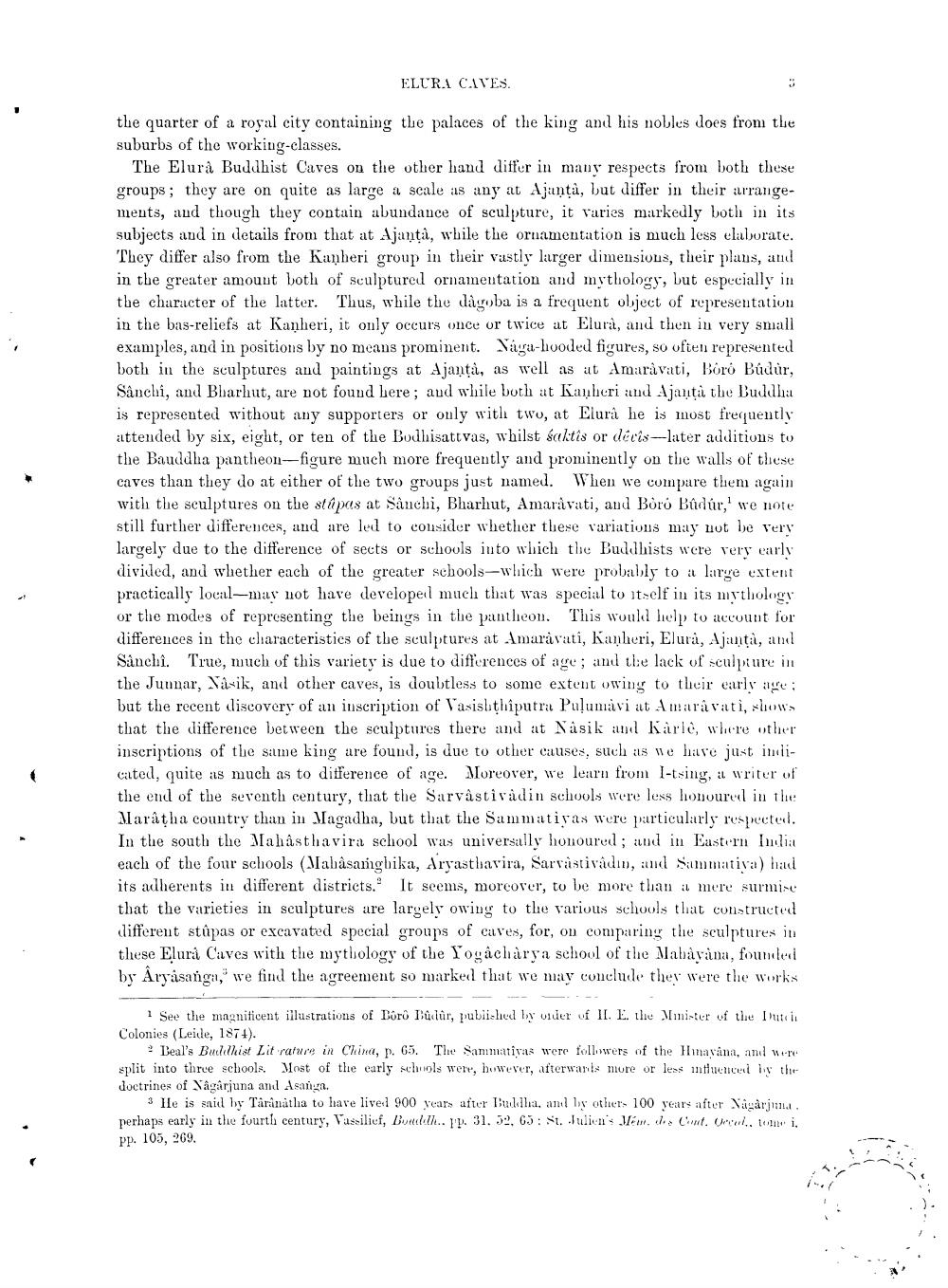________________
ELURA CAVES.
the quarter of a royal city containing the palaces of the king and his nobles does from the suburbs of the working-classes.
The Elura Buddhist Caves on the other hand differ in many respects from both these groups; they are on quite as large a scale as any at Ajuntà, but differ in their arrangements, and though they contain abundance of sculpture, it varies markedly both in its subjects and in details from that at Ajanta, while the ornamentation is much less elaborate. They differ also from the Kanberi group in their vastly larger dimensions, their plans, and in the greater amount both of sculptured ornamentation and mythology, but especially in the character of the latter. Thus, while the dagoba is a frequent object of representation in the bas-reliefs at Kanheri, it only occurs once or twice at Elurà, and then in very small examples, and in positions by no means prominent. Nagu-hooded figures, so often represented both in the sculptures and paintings at Ajautá, as well as at Amaravati, Bōró Búdúr, Sânchi, and Bharhut, are not found here; and while both at Kanheri and Ajanța the Buddha is represented without any supporters or only with two, at Elurâ he is most frequently attended by six, eight, or ten of the Bodhisattvas, whilst saktis or décis-later additions to the Bauddha pantheon-figure much more frequently and prominently on the walls of these caves than they do at either of the two groups just named. When we compare them again with the sculptures on the stúpas at Sanchi, Bharhut, Amaravati, and Boro Bûdúr, we note still further differences, and are led to consider whether these variations may not be very largely due to the difference of sects or schools into which the Buddhists were very early divided, and whether each of the greater schools-which were probably to a large extent practically local-may not have developed much that was special to itself in its mythology or the modes of representing the beings in the pantheon. This would help to account for differences in the characteristics of the sculptures at Amaravati, Kanheri, Elura, Ajantà, and Sanchi. True, much of this variety is due to differences of age; and the lack of sculpture in the Junnar, Nasik, and other caves, is doubtless to some extent owing to their early age; but the recent discovery of an inscription of Vasishthipatra Palumávi at Amaravati, shows that the difference between the sculptures there and at Nasik and Karle, where other inscriptions of the same king are found, is due to other causes, such as we have just indicated, quite as much as to difference of age. Moreover, we learn from I-tsing, a writer of the end of the seventh century, that the Sarvâstivadin schools were less honoured in the Maratha country than in Magadha, but that the Sammatiyas were particularly respected, In the south the Mahasthavira school was universally honoured; and in Eastern India each of the four schools (Mabásanghika, Aryasthavira, Sarvastivädin, and Summativa) had its adherents in different districts. It seems, moreover, to be more than a mere surmise that the varieties in sculptures are largely owing to the various schools that constructed different stúpas or excavated special groups of caves, for, on comparing the sculptures in these Elura Caves with the mythology of the Yogacharya school of the Mabayana, founded by Aryasanga, we find the agreement so marked that we may conclude they were the works
1 See the magnificent illustrations of Boro Büdür, published by order of II. E. the Mmister of the Dutch Colonies (Leide, 1874).
Beal's Buddhist Lit rature in China, p. 65. The Sammatiyas were followers of the Himayana, and were split into three schools. Most of the early schools were, however, afterwards more or less influenced by the doctrines of Nagarjuna and Asanga.
3 He is said by Târânatha to have lived 900 years after Buddha, and by others 100 years after Nagarjuna. perhaps early in the fourth century, Vassilief, Bouddh.. pp. 31. 52, 65: St. Julien's Mem, des Cont. Orcal,, tome i, pp. 105, 269.
-




